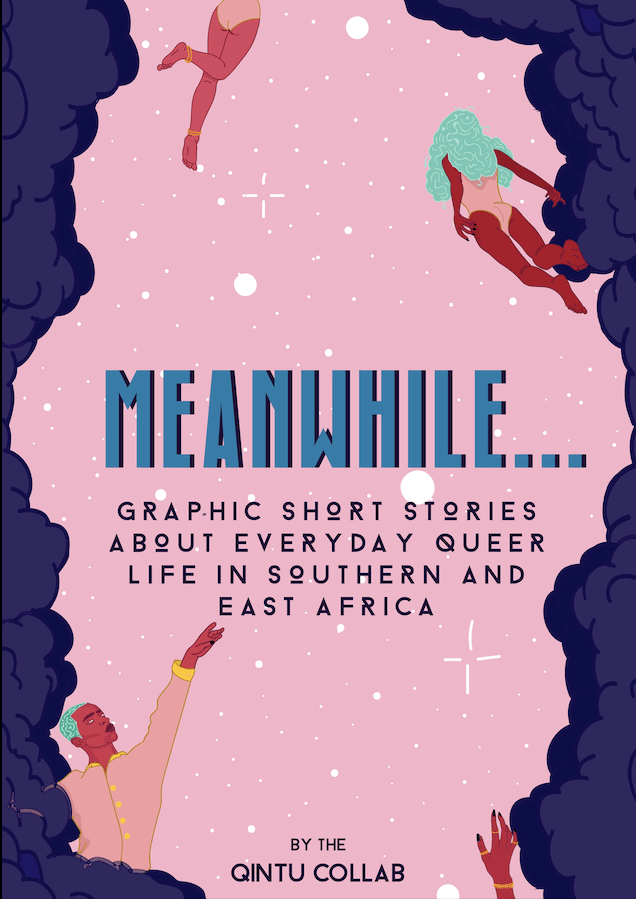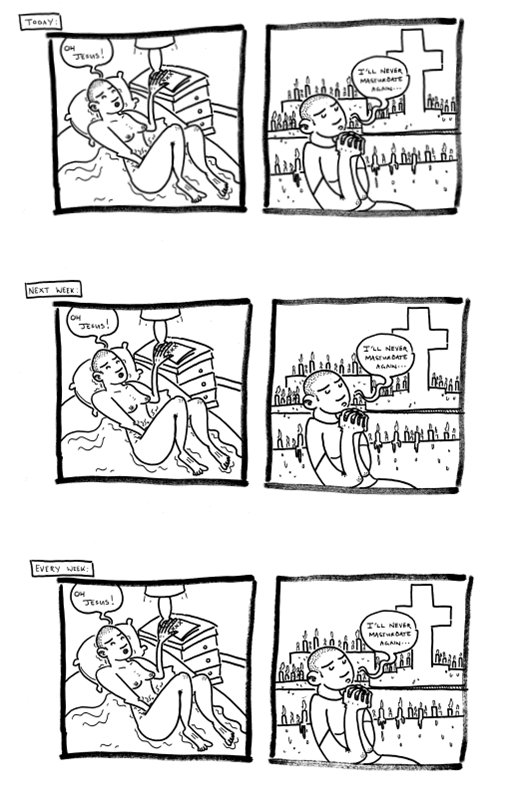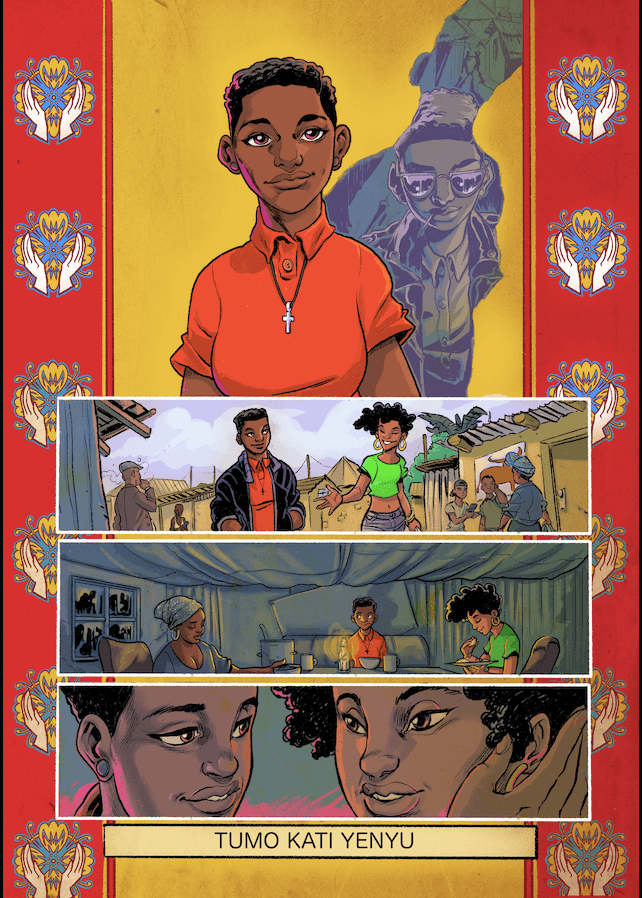Queer Love within, through and beyond Creative Queer African Collaboration
Representations of queer people on the African continent have been dominated by public health discourses on HIV [1] and heteronationalist discourses about queer people as perverse and ‘unAfrican.’ [2] In many countries, these are supported by colonial-era domestic laws that prohibit same-sex sexuality. As a result, queer people, affiliations, and identities are largely construed through the framework of sexual pathology or sexual deviance, [3] and queer people frequently experience rejection, violence, and social exclusion.
Against this background, the Qintu Collab was established by queer young people, artists and academics (the first and second authors) from South Africa, Zimbabwe, Botswana, and Kenya. Whilst conceptions of queer varied among members of the Collab, in this _Perspective, we intend the term as an anti-normative political identification, [4] which is oriented toward alternatives and potentialities beyond the frame of the everyday status quo, [5] as asserted by queer theorists in the global north. However, we also see queer as an identification that is open and amorphous enough to resonate with the forms of everyday sexual and gendered resistance that show up in African contexts, as well as other anti-oppressive efforts, such as black radical and decolonial politics.
A central component of our work together was the collaborative creation of a comic book called Meanwhile… Graphic Short Stories about Everyday Queer Life in East and Southern Africa. The collection of graphic short stories represents the everyday embodied affective experiences of young queer people on the continent as nuanced and plural, encompassing identity formation, spatial, social, spiritual and cultural affiliations, friendships, family, romantic, and sexual relationships. In this _Perspective, we reflect on the making of Meanwhile… as engaging with love as driver, method, and result of queer collaboration.
Here we think of love not in the neoliberal sense of monogamous romantic partnership, the exceptionalism that privileges the western fantasy of ‘true love,’ and the attendant nuclear family. [6] Instead, following Jennifer Nash, [7] we draw from both black radical and decolonial feminist lineages that see love as having the potential to transcend abjection of self and others (see for example Audrey Lorde, bell hooks, Cherrie Moraga, and Chela Sandoval); [8] and post-structuralist queer and feminist thought that sees love as an affect, a structuring force that inheres in/-between bodies and collectives (such as work by Sara Ahmed and Lauren Berlant). [9] Love can be a manifestation of “public feelings” as “global politics and history manifest themselves at the level of lived affective experience.” [10] Significantly, we do not make a distinction between love as a practice, emotion, or affect. As an embodied force, love pervades bodily practices, and can be identified as specific feelings of affection or affiliation, as well as a more ephemeral atmosphere or intensity that gathers (within) collectives, and directs political movements, all with the potential to spark transformations.
Many thinkers in the black radical tradition, including Steven Bantu Biko, Audre Lorde, bell hooks, and Cornel West, insist on the transformative potential of black love as an affirmation of the self against the diminishing effects of white supremacy, imbricated with cis-hetero-patriarchy. West [11] asserts that this effect “is not overcome by arguments or analyses; it is tamed by love and care.” But this is not a passive stance: “Love is a labor of actively reorienting the self, pushing the self to be configured in new ways that might be challenging or difficult.” [12]
This notion of self-love is intrinsically linked to community, because only in recognizing the self can one recognize those with whom one shares common conditions and life experiences. It is only through inter-subjective contact that the self comes into full view, it is only in reciprocal relations with others that we experience the fullness of humanity. [13]
Here the erotic is but one form of relation, albeit an important one, especially in a context where queer people, Africans, and young people have variously experienced othering and abjection on the basis of sexuality and gender; all the more so when these three identities intersect. [14] This is particularly significant given that same-sex sexuality is criminalized in many countries across the continent, including Kenya and Zimbabwe (Botswana decriminalized same-sex sexuality in June 2019, as we were concluding work on the comic anthology).
To collaboratively create representations of queer life, young queer Africans gathered to form the Qintu Collab. Through what we call “collaborative graphic autoethnography,” we collectively created the Meanwhile… anthology. [15] This methodological characterization hints at the relationship between self- and relational work, inherent to radical conceptions of love, and at the heart of the Qintu Collab. Through affirming creative self-exploration and iterative dialogical storytelling among critical but empathetic peers, young queer Africans (re)worked both subjectivity and relationships to (re)imagine and graphically represent African queerness. One collaborator described the significance of experiencing another “universal” come into view, outside of the hegemony of the global north:
What I liked most about collaborating with others was how compassionate and understanding we all were to each other while we told our stories, this made it easier for us to share free from any judgement, plus it also helped us in having a deeper understanding of each other hence creating a bond. […] Before, as strange as it may sound, I felt like all the problems and trials that I had gone through as a result of being queer were unique only to me, so being able to not only hear but see how universal they are made me feel less alone and validated. — Ted, Kenya
Here the universal, the common experience of humanity, the subjectivity on which knowledge-creation is grounded, is not that of the white European man, [16] but a shared condition of young African queers. It is forged through the experience of “compassion” and development of “deeper understanding” and “creating bonds,” which are co-terminous with feeling more “validated” within oneself.
Thus, queer love was central within the Collab. The work was driven by and centers love, by purposefully engaging the tenderness and enjoyment of personal and collective queer African identity, in a collaborative political action. Within it those who experience the burden of oppression, Fanon’s damnés, “give themselves to each other and are receptive to each other in love, understanding, and their shared rage” to imagine and action new ways of knowing and being, and to “build the world of [the] you.” [17] Such a world-building effort must be contextualized against the continued coloniality of law and rhetoric that demonize and criminalize queerness.

Most Collab members had never travelled outside of their home countries before, and during the course of working together individuals admitted fear and trepidation not only about traveling, but also about what Nairobi, a major African city where we gathered, and other Africans, would be like. Bound up in these fears were colonial, racialized, xenophobic notions about the dangers of (other) Africans. Thus, through the Collab, young people were able to confront these fears and forge loving bonds that transcend the colonial demarcations of nation-state as the basis of affiliation and solidarity. This saw the emergence or reification of Pan-African sentiments among Collab members. Following Pan-Africanism as espoused by African independence leaders, particularly Kwame Nkrumah, we refer to solidarity, collective pride, and struggle among continental Africans, grounded in shared and overlapping histories. [18] These histories — including colonization, the limits of African independence movements, and continued coloniality — see the continuation of queer criminalization and gendered oppressions. Such a definition does not necessarily preclude supportive relations with Africans in the diaspora, but these are not formative.
Closing reflections at the workshop, submitted either anonymously or attributed to Collab members describe Pan-African sentiments within the group, relating to a feeling of (renewed) pride, solidarity and agency:
The interactions and conversations reminded me of the power that we have. […] What was magical too was being around other Queer Africans, the reminder that we were here, proud and so powerful. — Pepper, Kenya
A week in Nairobi changed my life and my feelings about being an African queer… in as much as we were from different backgrounds and countries, the whole stories we share all bared some similar struggles l also went through in my country. This proved to me that as long as we are African, despite coming from different countries, we all had similar experiences and struggles; hence it is upon us to take this lead role in telling our own African queer stories. — Anonymous
I am really proud of seeing young black queer Africans owning their narratives and proving that we know what is best for us. — Brilliant, Botswana
The two latter quotes also hint at the importance of affirming representations of black African queer peoples where young people themselves take a “lead role in telling our own African queer stories.” Here then, magnetized to the idea of queer love, the Collab was the grounds on which young people could gather to form loving bonds. Through loving practices of self-expression and mutual compassion, they created loving representations of African queerness that themselves might forge other loving intensities in the world beyond the Collab.
The process of creative representations was a mode of epistemic disobedience, [19] making subaltern lived experiences sources of creative inspiration and action, as well as foundations of knowledge about queerness and African-ness. Significantly, amid hostile local media or in global queer representations that are largely commodified and white-washed, [20] such epistemic disobedience seeks to generate knowledge grounded in and concerned with the experience of queer African youth, which takes blackness, African-ness and queerness as given.
Its main purpose for me was to be a voice to the voiceless and help those who have no one, to know they are not alone. — Bubbly, Botswana
I’m also proud of being part of something bigger than myself especially if my experiences can be of help to someone out there then my work is done. — Ted, Kenya
Thus, the act of creating alternative representations was also clearly understood as an act of love for other young queer people across the continent who may not see their bodies, social contexts, and experiences represented in existing media. Outside the Collab, as a site of creation and epistemic disobedience rooted in queer love, the comic anthology takes on a (loving) life of its own, where it might gather others, and spark affective intensities, including love, farther afield.
Social media responses give us some insight into these more dispersed affects. For example, one reader and twitter user, @vumani_bo, [21] writes in two separate tweets:
[…] The illustrations are so beautiful. There is illustrations of black queer women fapping [masturbating].
It’s queer peoples retelling their own stories, and the drawings have so much life. Blackness, being African is more than just pain and it’s not monolithic. […]
The reader expresses being affected by the work, the emotional intensities inscribed into the images “catching others,” [22] drawing them into the loving gathering of damnés. They especially mention a comic that shows a “black queer woman fapping [masturbating].” Perhaps, given the stigma attached to both queer and feminine sexuality, and the dearth of positive representations of black women in particular, the portrayal of masturbation is especially striking for the reader.
In the comic (Fig. 2), masturbation, an erotic expression of queer self-love, is contrasted with the damning effects of religious guilt. Whilst the comic is a comedic take on the tension between sexual experience and expression, on the one hand, and the valorization of deprivation and restraint in some of the religious teachings that Collab members have experienced, on the other, it also points us to the conditions of constraint and contradiction under which queer Africans love and actualize their sexual and spiritual selves. Far from being incompatible or exclusive, the comic visualizes both queer masturbation and guilty prayer, as a persistent and enduring tension, through the repetition of the two panes over three temporalities: the present, the future and always, or “Today,” “Next week,” and “Every week.” Here “queer failure” is not negative or negating. [23] Instead, subjecthood is constituted both through sexual pleasure and religious belief or affiliation, and (auto)eroticism charges the affectivity, physicality, and spirituality of self-love as feeling and practice.

As this reader highlights in their tweets, against the diminishing effects of othering health and politico-legal discourses that shape the representation of queer Africans, Collab members did not want to perpetuate the idea of queer Africans as “just pain” ravaged by (sexually transmitted) diseases or as violated and rejected by families, society, and the state. Instead they portrayed their sexuality both as a site of struggle and pleasure, and as being imbricated with their positioning in society and relationships. For this reason, images that depict young queer people as queer and within churches, relationships, families, and communities were prominent in the anthology.
One example from the anthology, a silent comic (Fig. 3), shows a young person going about her day in her neighborhood, and then having a meal with her mother, all alongside her partner. The image is ambiguous about how open the couple are about their relationship, and they are not portrayed as visibly intimate until the last panel, when it seems that they are alone. In this way the author and artist does not shy away from the dangers and stigma associated with queer intimacy or the need for caution but directs us to the everyday nature of queer and familial love, even under conditions of constraint. Seeing African queer love and family love in the same frame (both literally and theoretically), though perhaps unresolved, alerts us to how these are not mutually exclusive feelings or experiences, and how subjects hold multiplicity and ambiguity in everyday life.

The comic anthology Meanwhile… is a testament to the embodied affective experience of queer self-love, interpersonal relationships, and collective solidary love. It is, in this sense, what Ann Cvetkovich [24] understands as an archive of feelings, manifested not through institutions (such as museums or state records) but through everyday action. By gathering and inciting feelings in and among others, this book-archive also mobilizes other affective, perhaps loving, forces in the world for queer people beyond the Collab. Finally, although this was not a central concern of the collaboration, the book can be seen as a form of public engagement that aims to reach beyond the alternative or marginal positioning of queer life, by asserting the right to occupy a social, creative, discursive space which queers are constantly excluded from or objectified in, and to disrupt the idea of (African) society as straight and cisgender. [25] Perhaps in seeking to render queer African people intelligible to wider society, this book is also both a critique and an effort to extend love to those who refuse us.
_ Authors’ Notes
All quotes are used as they appear in original. We purposefully do not use the convention of denoting grammatical/ spelling or other errors with ‘sic’ because we do not want to correct or discipline someone else’s words through academic convention. This is part of a larger effort to break down the distinction between academic and popular discourse and to de-center academic English.
The graphic anthology Meanwhile… Graphic Short Stories about Everyday Queer Life in East and Southern Africa is published by MaThoko’s Books, and available online through African Books Collective:
<http://www.africanbookscollective.com/books/meanwhile../>
_How to Cite
Talia Meer and Alex Müller with the Qintu Collab. “Queer Love within, through and beyond Creative Queer African Collaboration.” On_Culture: The Open Journal for the Study of Culture 9 (2020). <http://geb.uni-giessen.de/geb/volltexte/2020/15446/>.

_Endnotes
- [1] Talia Meer and Alex Müller. “Transnational Funding and Local Identities: Homonormativity and HIV in Malawi,” paper presented at the European Geographies of Sexualities Conference, Prague; 2019.
- [2] Ryan Richard Thoreson, “Troubling the Waters of a ‘Wave of Homophobia’: Political Economies of Anti-queer Animus in Sub-Saharan Africa,” in Sexualities 17.1–2 (2014), 23–42.
- [3] Sylvia Tamale, ed. African Sexualities: A Reader (Nairobi: Fahamu/Pambazuka, 2011), here: 656.
- [4] Lauren Berlant and Michael Warner. “Guest Column: Guest column: What Does Queer Theory Teach Us about X?,” in Publications of the Modern Language Association of America (1995), 343–349, here: 349.
- [5] José Esteban Muñoz, Cruising Utopia: The Then and There of Queer Futurity (New York: New York University Press, 2009).
- [6] Elizabeth Povinelli, “Spiritual Freedom, Cultural Copyright,” in: The Empire of Love: Toward a Theory of Intimacy, Genealogy, and Carnality (Durham: Duke University Press, 2006), 95–174.
- [7] Jennifer C. Nash, “Practicing Love: Black Feminism, Post-Intersectionality,” in Meridians 11.2 (2011), 1–24.
- [8] Cherríe Moraga, Loving in the War Years: Lo Que Nunca Pasó Por Sus Labios (Boston: South End Press, 1983); Audre Lorde, Sister Outsider (Berkley: Crossing Press, 1984); Chela Sandoval, Methodology of the Oppressed (Minneapolis: University of Minnesota Press, 2000); bell hooks, All about Love: New Visions (New York: William Morrow and Company, Inc, 2000).
- [9] Sara Ahmed, The Cultural Politics of Emotion. Second edition (London: Edinburgh University Press, 2004), 1–224; Sara Ahmed, “Collective Feelings: Or, the Impressions Left by Others,” in Theory, Cult Soc 21.2 (2004), 25–42; Lauren Berlant, Cruel Optimism (Durham: Duke University Press, 2011).
- [10] Ann Cvetkovich, “Public Feelings,” in South Atl Q 106.3 (2007), 459–468, here: 461.
- [11] Cornel West, Race Matters (New York: Vintage Books, 1993), here: 18.
- [12] Nash, “Practicing Love”, here: 11.
- [13] Nelson Maldonado-Torres, “Outline of Ten Theses on Coloniality and Decoloniality,” (2016), accessed January 30, 2020 <http://frantzfanonfoundation-fondationfrantzfanon.com/article2360.html>, 1-37.
- [14] Lorde, Sister Outsider.
- [15] Talia Meer and Alex Müller, Making ‘Meanwhile…’: Representing Queer African Youth through Spontaneous Collaborative Graphic Autoethnography. Forthcoming.
- [16] Walter D. Mignolo, “Introduction: Coloniality of Power and De-colonial Thinking,” in. Cult Stud. 21.2–3 (2007), 155–167.
- [17] Maldonado-Torres discussing Fanon, “Outline of Ten Theses”, here: 29.
- [18] Ama Biney, The Political and Social Thought of Kwame Nkrumah. (New York: Palgrave MacMillan, 2011).
- [19] Walter D. Mignolo, “Epistemic Disobedience and the Decolonial Option: A Manifesto,” in Transmodernity J Peripher Cult Prod LusoHispanic World 1.2 (2011), here: 4467.
- [20] Mattilda Bernstein Sycamore, That’s Revolting: Queer Strategies for Resisting Assimilation (Brooklyn: Soft Skull Press, 2004).
- [21] @vumani_bo, Twitter, Inc., (2019), accessed February 17, 2020, <https://twitter.com/vumani_bo/status/1178381874147799041?s=19>.
- [22] Florentien Verhage, “Living with(out) Borders: The Intimacy of Oppression,” in Emot Sp Soc. 13 (2014), 111–120, here: 98.
- [23] Jack Halberstam, The Queer Art of Failure (Durham: Duke University Press, 2011).
- [24] Ann Cvetkovich, An Archive of Feelings: Trauma, Sexuality, and Lesbian Public Cultures (Durham: Duke University Press, 2003).
- [25] Lauren Mompelat, “Queer of Colour Hauntings in London’s Arts Scene: Performing Disidentification and Decolonising the Gaze: A Case Study of the Cocoa Butter Club,” in Fem Theory 20.4 (2019), 445–463.


